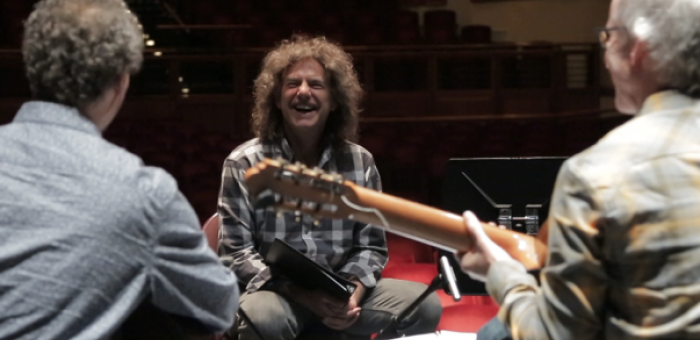Dec 9, 2025 12:28 PM
In Memoriam: Gordon Goodwin, 1954–2025
Gordon Goodwin, an award-winning saxophonist, pianist, bandleader, composer and arranger, died Dec. 8 in Los Angeles.…

Pat Metheny (center) with members of the Los Angeles Guitar Quartet prior to the group’s performance of Road To The Sun in Denver on Oct. 20
(Photo: Tara Stewart)On Oct. 20, guitarist Pat Metheny appeared at the University of Denver to oversee the performance of Road To The Sun, a commissioned suite he wrote for the Los Angeles Guitar Quartet. In an afternoon Q&A session, Metheny met with university students to shed light on the composition. Below are excerpts from the conversation.
On the resurgence of guitar quartets in contemporary classical music and jazz:
Since the emergence of the LAGQ and a couple of other quartets, classical guitar quartets have become quite a thing. It was a different challenge to write for this combination—different than writing for a string quartet, where the instruments have very different personalities and sonic fingerprints.
Unbeknownst to me, LAGQ recorded a piece of mine, “Letter From Home,” on their album Guitar Heroes. They played it great and the record won a Grammy [for Best Classical Crossover Album]. After I heard them live a few years ago, I decided I really wanted to write for them. I was on vacation with my family when I started.
This thing just emerged and wound up being about 30 minutes long. The general shape of the piece just poured out, but it took a lot of time to orchestrate it and come up with about 300 pages of very detailed guitar music ….”
I was in California a couple of weeks ago to play some festivals, and I had a day off and spent about eight hours with them rehearsing it. They have been working really hard on it since then. We spent a couple of hours on it yesterday, and tonight it will be heard for the first time. These guys are at the absolute pinnacle of what can be done with this instrument now.
On quantifying elements of his writing in this piece:
This is the first time I have tried to quantify the things I do in a piece. Every composition has its own cultural and social thing. Improvisation is at the top of the list of things I want to do. If I’m writing a tune that Kenny Garrett will play, I just need to give him a melody and chord changes and he’s going to do something with it that is better than I could have imagined. That wasn’t the case here; I quantified my ideas into specific notes.
There are many aspects of my style. For instance, I like to have all 12 notes available on any chord at any time, and rhythm and groove are very important in my music. I knew going into this that rhythm would be the most challenging thing about this piece for LAGQ. But groove is an area of interest to these guys—more than it is with other classical guitarists. They have shown that they know how to groove.
As I was writing the piece, I was going for the things I do all the time—like reaching my left-hand thumb onto the bass strings for voicings that can’t be played otherwise. I know classical guitarists don’t do that—the thumb is always behind the neck. I decided to call them up and ask if they would be OK with me writing chords using the thumb—they said no. So I reworked the voicings to get the chords I wanted without that.
On giving the piece a structure:
When I write, I think of storytelling. In jazz, I don’t think of writing pieces in movements. The Way Up, [a 2005 album by the Pat Metheny Group], was one long, continuous piece. I thought of the individual pieces for [the 2010 Nonesuch album] Orchestrion as being related, but not as movements. Road To The Sun is in six movements, and some of them overlap.
I was thinking that 50 years from now, someone is going to want to play this piece. So every note that [LAGQ] plays in it is written out. This was really different territory for me.

Goodwin was one of the most acclaimed, successful and influential jazz musicians of his generation.
Dec 9, 2025 12:28 PM
Gordon Goodwin, an award-winning saxophonist, pianist, bandleader, composer and arranger, died Dec. 8 in Los Angeles.…

Belá Fleck during an interview with Fredrika Whitfield on CNN.
Jan 13, 2026 2:09 PM
The fallout from the renaming of the John F. Kennedy Center for the Performing Arts to include President Donald…

Flea has returned to his first instrument — the trumpet — and assembled a dream band of jazz musicians to record a new album.
Dec 2, 2025 2:01 AM
After a nearly five-decade career as one of his generation’s defining rock bassists, Flea has returned to his first…

“It’s a pleasure and an honor to interpret the music of Oscar Peterson in his native city,” said Jim Doxas in regard to celebrating the Canadian legend. “He traveled the world, but never forgot Montreal.”
Nov 18, 2025 12:16 PM
In the pantheon of jazz luminaries, few shine as brightly, or swing as hard, as Oscar Peterson. A century ago, a…

Dec 11, 2025 11:00 AM
DownBeat presents a complete list of the 4-, 4½- and 5-star albums from 2025 in one convenient package. It’s a great…